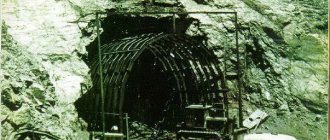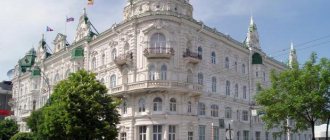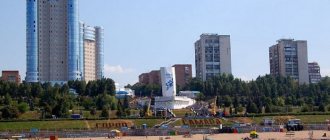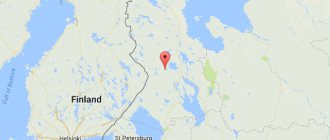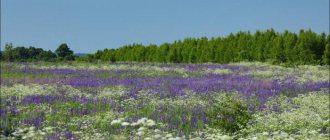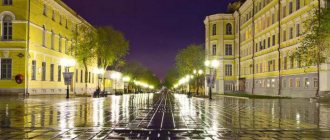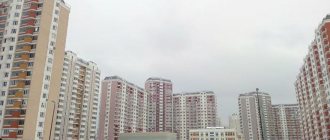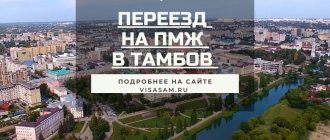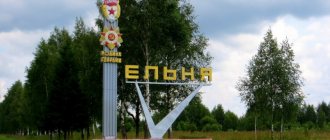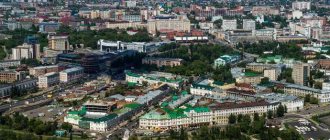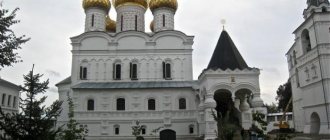Founded: 1032
Kursk is a city with a rich history and cultural heritage
Kursk
- a city in Russia, on the Seim River, the administrative center of the Kursk region.
The distance to Moscow is 537 kilometers. The inhabitants of the city are called Kuryans
.
The first written mention of Kursk dates back to 1032
. Kursk was part of Chernigov, then Pereyaslavl and Novgorod-Seversky principalities. In 1095, the ruler of Kursk was the son of Vladimir Monomakh - Izyaslav, in 1185 - one of the heroes of “The Lay of Igor’s Campaign” Vsevolod Trubchevsky.
The people of Kursk took part in the famous Battle of Kalka in 1223. In the 13th century, the city was the center of an appanage principality, and in 1238 the city was ravaged by the Mongol-Tatars. The principality was actually ruled by the khan's baskak, who bought tribute to the principality from the khan of the Golden Horde. In 1284, the city was devastated for the second time by the Tatars for an insult to the Baskak.
In the second half of the 14th century, under Prince Olgerd, Kursk, together with the lands of the principality, went to Lithuania. As a Lithuanian city, it is mentioned in the treaty with the Teutonic Order in 1402. In the 15th and early 16th centuries, raids by the Crimean Tatars and Nogais led to the desolation of the city. In fact, only a century later the city arose anew and in a new place.
The Triumphal Arch is part of the memorial complex. In 1503, the territory of the Kursk Principality was returned to the Russian state. Modern Kursk developed from a border town. Tsar Fyodor Ivanovich ordered the construction of a new fortress in Kursk on the route of the Crimean Tatars' raids (1597). This fortress experienced repeated sieges during the Time of Troubles, the last one in April 1634 during a raid by 12 thousand Zaporozhye Cossacks led by Hetman I. Cherny.
In the 18th century the city became an important center of trade and industry. In 1797, the Kursk province was formed. In the mid-19th century, a local newspaper began to be published, a telegraph station was opened, a railway connected Kursk with Moscow, and industrial development began: tanneries, a bacteriological laboratory, and a distillery began operating.
During World War II, the city was taken by the Nazis. In the summer of 1943, the legendary Battle of Kursk took place here. The Germans practically wiped the city off the face of the earth. But after the war, the city was relatively quickly restored and expanded.
Today Kursk is a large industrial, cultural and scientific center of the Kursk region. Energy, mechanical engineering and metalworking, chemical, petrochemical, food and light industries are developed here. The most important energy enterprise, the Kursk Nuclear Power Plant, is located 40 kilometers southwest of the city.
On April 27, 2007, by Decree of the President of the Russian Federation, Kursk was awarded the honorary title “City of Military Glory.”
Sergius-Kazan Cathedral
Kursk is rich
monuments
of the 18th and 19th centuries. The most significant are the mansion of the merchant Khloponin, the Sergius-Kazan Cathedral (1778), the building of the former Assembly of the Nobility, the building of the former men's gymnasium, the chambers of Hetman Mazepa and others. The city has 6 museums, 3 exhibition halls, 8 libraries, 3 theaters, 33 churches, memorial complexes to those who fell during the Great Patriotic War and the Kursk Bulge.
The outstanding Russian actor M.S. lived and served in a private theater in Kursk. Shchepkin, the famous Soviet artist Alexander Deineka and others worked.
The city's population is more than 450 thousand people (2020).
Day of the city
Kursk is celebrated annually in September.
Dynamics by year
At the beginning of 2000, about 1.281 million people lived in the Kursk region. This number has been constantly decreasing due to natural population decline and the outflow of residents to other regions of the country. In Kursk itself, according to data for 2000, there were 443,500 inhabitants.
This number has changed slightly over the past two decades, increasing and decreasing, until it stopped at 452,000. The increase in the number is due to the immigration influx of residents from the region and neighboring regions; a natural decrease is still observed; a natural increase was recorded only in 2015 year.
The birth rate is gradually increasing. Despite the fairly high level of migration, natural population growth can correct the generally negative population dynamics. For this purpose, various programs are carried out both at the regional and federal levels.
Administrative division
Modern Kursk consists of 3 districts: Central, Seimsky and Zheleznodorozhny. It is noteworthy that until the spring of 1994 they bore the names of Leninsky, Industrial and Kirovsky districts, respectively. Most of the population of Kursk is concentrated in the Central District. The number is about 214 thousand people. Back in the early 2000s, similar figures barely reached 180 thousand inhabitants. One of the main reasons for demographic growth is the expansion of territory. Now the area covers an area of 85 square meters. km. The share of children and adolescents here is about 35%.
The population of the Seimas district varies within 150 thousand inhabitants. Unlike the Central region, the population here is gradually declining. Compared to 2000, there are now almost 25 thousand fewer residents in the district. A quarter of the properties are occupied by park areas. The population of the Railway District is about 70 thousand people. This is the smallest district of the city. Only in recent years has its demographic size begun to grow.
Compound
Most of the residents of Kursk are Russians, their share of all residents is about 96%. Ukrainians are in second place (about 1% of them live in the city). There are also Armenians, Gypsies, Belarusians, Azerbaijanis and other nationalities, but their share among the entire population is no more than 0.3%.
The ratio of residents of cities and rural settlements is 2 to 1. The former account for about 65.2%, the latter – 34.8. At the same time, the following ethnic groups most often live in cities: Russians (98%), Belarusians (75%), Bulgarians (74%), Uzbeks (68%), Tatars (67%), Chuvash (67%), as well as Ukrainians ( 65%).
Men and women
The gender ratio of residents is 45.5% to 54.5%. These are natural indicators for most cities in the Russian Federation, as well as developed countries in general. For every 1,000 men in Kursk, there are about 1,198 women. This ratio is a consequence of big problems not only in this region, but also in Russia as a whole. The reason lies in several wars in which the USSR and then the Russian Federation participated during the 20th and 21st centuries. The collapse of the Soviet Union also made a big contribution.
The 90s were marked by big problems in the economic and social spheres. As a result, not only did overall mortality increase (at the same time, significantly more men died due to well-known reasons), but birth rates also worsened, as well as the number of new marriages and families. At the moment, the situation is gradually beginning to improve due to the competent policies pursued by the government of the Russian Federation.
Population of the City of Kursk as of January 1, 2022
Their importance for the development of industry, trade and agriculture is difficult to overestimate. In the Kursk region, a solemn meeting marked the 10th anniversary of the formation of the Air Force of the Russian Federation.
Since April 2014, a new project for parents of preschool children, “Healthy Family – Healthy Children,” has been implemented on the psychological education of parents and the formation of a psychological culture of the family.
The food production index for January-June 2022 was 100.1%. During the analyzed period, production in physical terms of beef, pork, preserved fish, vegetable and fruit juices for baby food, spreads, vegetable oil, soybean oil, cheeses, fermented milk products (except sour cream), condensed milk products, flour, and mineral water increased.
As reported by the city administration, this year the population of Kursk has decreased by one person. link:.
During times of peaceful life it increased, but during subsequent enemy raids it decreased. However, there were times when the demographic situation improved.
Due to the fact that in the 17th century the fortress city of Kursk served to strengthen the Belgorod defensive line, some of the residents from Central Russia were transported here. Almost at the same time, our region was a place of exile for the unwanted.
A noticeable increase is also associated with Catherine’s reforms. This was also observed during the construction of the railway that passed through the Kursk lands.
The first national census was conducted on February 9, January 28, old style. What did the Kurdish people learn about themselves then? The total population of the province was 2 people.
Women had a numerical superiority over men; only in the provincial Kursk there were more men.
Among the foreigners living there were immigrants and nationals of Germany, Austria-Hungary, France, Turkey - a total of 27 states.
In the cities, especially in Kursk and Belgorod, lived a significant part of the townspeople, merchants, privileged classes of hereditary and personal nobles, and honorary citizens.
Made a contribution - receive interest on the funds credited to the escrow account The Center for the Fourth Industrial Revolution Peskov may appear in the Russian Federation: the presidents of the Russian Federation and Ukraine may discuss the issue of gas transit in Paris The government has calculated the number of migrants needed to work in the Russian Federation this year The Ministry of Finance intends to limit the work of branches foreign insurance companies.
The Ministry of Finance intends to limit the work of branches of foreign insurance companies. A Center for the Fourth Industrial Revolution may appear in the Russian Federation. Made a contribution - receive interest on the funds credited to the escrow account. The concept of a system for guaranteeing the rights of non-state pension funds was published. Main Documents Experts.
Advanced search Resolution of the Administration of the city of Kursk, Kursk region from Establish that the functions for the implementation of state powers of the Kursk region to organize and implement compensation payments in connection with the costs of paying for residential premises and utilities are carried out by: - the social protection body - the social protection and guardianship committee the city of Kursk in terms of making a decision on the appointment of compensation payments in connection with the costs of paying for residential premises and utilities and their implementation; — the authorized institution is the municipal institution “Center for Communal and Social Services of the City of Kursk” in terms of reception, verification of documents, calculation and recalculation of compensation payments in connection with the costs of paying for residential premises and utilities. Committee for Social Protection of the Population and Guardianship of the City of Kursk Tsvirova S.
During times of peaceful life it increased, but during subsequent enemy raids it decreased. However, there were times when the demographic situation improved.
Due to the fact that in the 17th century the fortress city of Kursk served to strengthen the Belgorod defensive line, some of the residents from Central Russia were transported here. Almost at the same time, our region was a place of exile for the unwanted.
A noticeable increase is also associated with Catherine’s reforms. This was also observed during the construction of the railway that passed through the Kursk lands. The first national census was conducted on February 9, January 28, old style. What did the Kurdish people learn about themselves then?
New tariffs for garbage collection in the Southwestern zone were adopted back in June, and in the Northeastern zone at the end of August. The issue is very relevant and concerns all residents of the region. Tariffs have increased significantly, but the quality of service has not improved.
Why this happened and whether it is possible to reduce the fee - deputies tried to figure this out. This is also due to the increase in life expectancy of the population. Additional agreement on amendments to the regional agreement on the minimum wage in the Republic of Tyva dated January 27, September 1.
Marriages and divorces
In the region during 2022, 7,175 marriages and 4,871 divorces were recorded. There are 6.5 marriages and 4.4 divorces per 1,000 inhabitants. Most of them are among residents aged 20 to 30 years. It is worth noting the general decrease in the number of new families created. The reason is that the 1990s generation is ready for marriage, but the number of children born in this decade is much less than before and after it.
Marriages in the Kursk region by year
On the positive side, it is worth noting that only a fifth of marriages break up within the first few years after starting a new family. Moreover, in 80% of cases people have minor children who, after the divorce process, remain to live with one of the parents.
Divorces in the Kursk region by year
Migration
During 2022, about 32 thousand people arrived in the city, and about 29 thousand left; the migration increase is 3 thousand. 25 thousand of them move within Russia, half change their locality in the Kursk region, and the other half prefer to come to Kursk from another region or move to another region. About 6,000 people came from foreign countries (part of the CIS), but only 1,200 left Kursk. 1,090 and 2,180 people interacted with other countries in this regard (arrived and left, respectively).
The reasons for the positive migration flow are the good economic situation both in the region and in the city itself. More than 30 thousand enterprises and individual entrepreneurs operate in Kursk. Most of them work in the energy sector (a third of all industries), mechanical engineering (a quarter of all industry) and petrochemical (14%) industries.
Kursk has a low unemployment rate - a specialist with sufficient qualifications and level of education will have no problems finding a job. The employment assistance service actively helps with this - job fairs and advanced training courses are regularly held.
Nevertheless, a number of Kursk residents leave the city and region for predominantly more developed and larger cities. The main reasons for this are obtaining a quality education and changing jobs to obtain a higher-paying and promising job. Some citizens return back after receiving higher education, since enterprises in Kursk can provide their employees with well-paid jobs with prospects for further development.
Settlement history
The first communities in the city began to form at the beginning of the 5th century. Several hundred years later, a large settlement appeared on the banks of the Kur River. Local residents were mainly engaged in trade. Even then, Kursk was an important economic center of the region, which is why it attracted thousands of new settlers. In 1095, an appanage principality of the same name was founded here. During the reign of Izyaslav Monomakh, a powerful fortress appeared at the gates of the settlement. Since the beginning of the 12th century, the city was the most important outpost of all Kievan Rus. Craftsmen and traders from all principalities came here. With this, the urban population increased significantly. The population of Kursk in those days reached several thousand people.
In the mid-13th century, the city was destroyed by the Mongol-Tatars. The remnants of the principality were ruled by subjects of the Golden Horde. Gradually, the Slavic ethnic group began to be diluted by the Mongoloid race. At the end of the 14th century, the region passed to the Principality of Lithuania. However, until the 16th century, the settlement was subject to numerous raids by Nogais and Tatars. The date of the city's rebirth is considered to be 1586.
